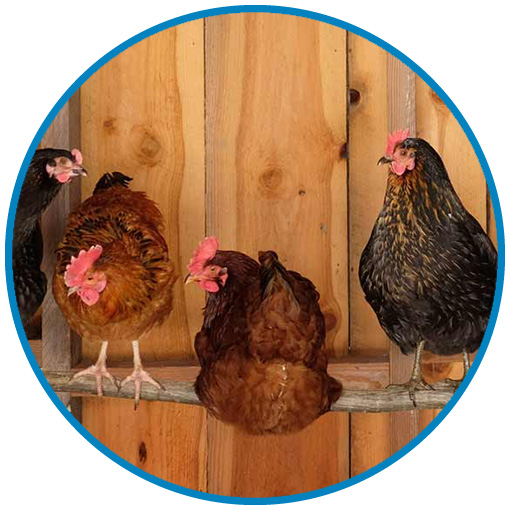 Chicken Coop Requirements 101
Chicken Coop Requirements 101
A hen’s coop is her castle! Proper housing is the key to happy, healthy birds, but building a chicken coop to the proper specifications is not as simple as it might seem. An adequate chicken coop design must be predator proof, secure, have adequate ventilation, easy to clean, have roosts, should have nesting boxes, and be spacious enough for your flock.
Predator Proofing
Chicken coops NEED to be predator proof; and not just from the sides, but from above and below as well. Predators that would love chicken wings for dinner include but are not limited to raccoons, foxes, wolves, coyotes and hawks — just to name a few! A PRO TIP from a fellow chicken owner: be sure to select the correct wire mesh. The holes in standard “chicken wire” are actually quite large and are designed to keep chickens in an enclosed area – not keep predators out! Raccoons and other smaller predators can easily reach through those holes and do some pretty nasty things… Not a pretty sight. We recommend one-half inch square “hardware cloth” which is designed to keep predators out. More on predator proofing here.
Security
In addition to being predator proof, your chicken coop needs to be secure from nasty rodents such as rats and mice (and even the occasional snake) that will be attracted to the feed and droppings. Rodents are burrowing creatures, so you need to block them from slipping into the coop from below.If you coop doesn’t have a floor, you need to bury small-mesh fencing (hardware cloth) down into the ground about 12″ all around the coop — or at least out away from the coop (like an “L” shape) to prevent not only rodents, but other predators from digging under the coop and entering through the floor. It may not be a bad idea to even raise your coop up off the ground; however, that may not be feasible depending on your coop’s design.
Ventilation
Keeping your coop well ventilated means that it should have enough cross-breeze to prevent respiratory diseases, to which chickens are especially prone, but not so drafty during winter that they freeze their tushes off. Chickens can withstand the cold so long as it’s not drafty!
Easy to Clean
It goes without saying, but cleanliness is super important. Especially with an animal which is extremely well known for pooping … everywhere! Having a floor that it easy to keep clean from bugs and bacteria is important, so keep this in mind when building your chicken coop!
Roosts
Provide “roosting poles” for your girls to sleep on will help keep your hens comfortable. Roosting poles should optimally be 2″ or 3″ wide with rounded edges, allotting about 5″ to 10″ of space per bird side to side and 10″ between poles if more than one is necessary. Also, staggering the poles in a ladder-like grading so the pole furthest away is several inches higher than the closest isn’t a bad idea. Essentially, you don’t want poles on top of each other, otherwise the birds will poop on each other (which in addition to being just super nasty, also leads to tons of health problems).
Nesting Boxes
To encourage egg-laying, it’s recommended that you have 1 nesting box for every four or five chickens. Nest boxes should be raised off the ground at least a few inches, but lower than the lowest roosting pole (otherwise they’ll sleep in them and poop everywhere – including all over your eggs). They should also be dark and “out of the way” to cater to the hen’s instinct to lay her eggs in a safe place. The reality is that many hens may simply ALL choose the same box even though there are several to choose from, and there’s not a darn thing that you can do about it. It’s just the way of things haha!!
Having Enough Room
A coop needs to be roomy enough for comfort. This means at least 4 square feet per bird if birds are able to roam freely during the day, and at least 10 square feet per bird if they are permanently confined. Please note: coop manufacturers determine how many birds their coop can comfortably hold, but coop size regulations vary by area, and local requirements may require a larger coop. Before making a coop purchase, it is a good idea to consider local laws, your personal situation, and how much room you feel your flock needs for your management style. Chickens generally use very little indoor space, preferring to be outdoors except when sleeping.
Additional Thoughts…
Many folks ask if food and water should be in the coop. The answer we typically recommend is NO – those should (optimally) be in the run, not the coop. They should also be several inches off the ground or hung from above to avoid allowing the chickens to accidentally contaminate the feeder or waterer; or spill it all over the ground.
Since cleanliness of your coop is paramount, we definitely recommend including a removable “droppings tray” under roosting poles for capture and easy disposal of droppings. (Or should we say for easy access to your lawn fertilizer?)
Lastly, the Chicken Run! Similar to the coop, the sides of the attached chicken run, if you have one, should be buried 12″ into the soil to keep predators and rodents from digging their way in. Once again, we recommend chicken wire fencing or half-inch hardware cloth. It’s also our strong recommendation that you secure the top of the run with aviary netting or deer netting. This will keep wild birds (which can carry communicable diseases) out and provide further defense against sly predators.
